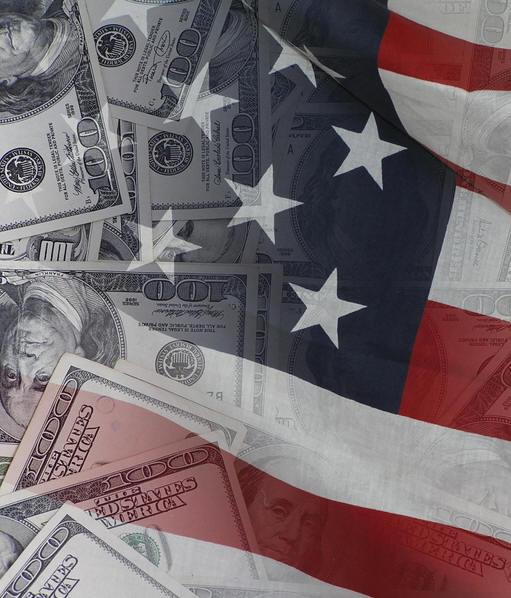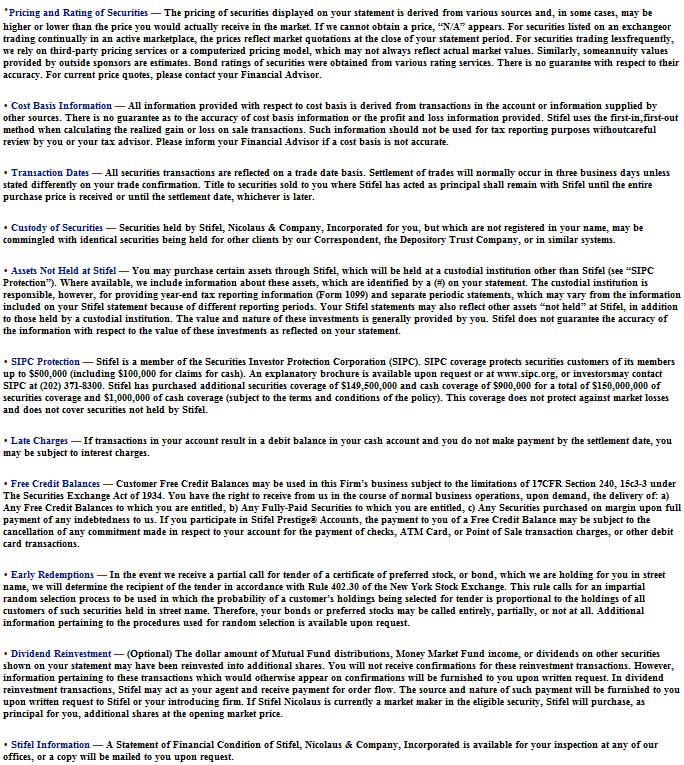|
ROLLOVER
CENTER |
| |
|
| |
STIFEL NICOLAUS |
| |
|
|
Investment StrategistTM
What Can a Presidential Election Year Mean for the Markets?
September 2008
|
With the
Presidential election just around the corner, much is being made
about the candidates� plans for the economy. But do Presidential
elections themselves have an impact on the stock market? Past
performance certainly cannot guarantee future results, and
economists may differ in their opinions as to how much politics
influences the economy; however, historically, the financial
markets have fared well during a Presidential election year.
The
Presidential Election Cycle Theory
The Presidential Election Cycle is a theory that attempts to
forecast the performance of the stock market. Developed by market
historian Yale Hirsch, it posits that the stock market follows a
cyclical performance that corresponds with the four-year
Presidential term.
|
 |
|
According to the Presidential Election Cycle theory, the market
fluctuates in fairly regular patterns over the course of a
Presidential term, with the first two years of the term tending to
be the weakest. Years three (the pre-election)
and four (the election year), according to the theory, typically
offer stronger returns for the stock market. |
S&P 500 Returns by U.S.
Presidential Term Year, 1948-2007
Average
1st Year
2nd Year
3rd Year
4th Year (Election Year) Annual Return
7.35%
10.16%
22.29%
12.18%
|
The
gain/loss information on your account may have changed due to
enhancements in Stifel� cost basis system. Gain/loss
estimates are provided for informational purposes only, and
should not be used for tax preparation without the assistance of
your tax advisor. Cost basis may be adjusted for, among other
items, amortization, accretion, principal paydowns, capital
changes, or listed option premiums. Please contact your
Financial Advisor with any questions. |

V i s i o n
� P l a n n i n g
�
Focus
SNINS060801 |
|
|
|
What Can a
Presidential Election Year Mean for the Markets? |
|
|
|
The
assumptions of the Presidential Election Cycle theory are:
� The stock market performs well in a Presidential election
year.
� The market does even better in the year preceding the
election.
� Years three and four of the Presidential term are typically
the best-performing years of the cycle.
� The first two years of a Presidential term are typically the
worst-performing years of the cycle. |
Presidential Election Year Performance
Historically, the Dow Jones Industrial Average has
recorded significant gains during the fourth year of a Presidential
cycle, also known as the Presidential election year. The average Dow
Jones performance during Presidential election years, since 1960, is a
gain of 7.7%, with nine up years compared to three down years.
So why does the stock market typically do well in a
Presidential election year? The answer, according to advocates of the
theory, is relatively simple. According to Hirsch, the reason behind
this cycle is that �incumbent administrations during election years
try to make the economy look good.� During a Presidential election
year, regardless of whether a Democrat or Republican is in office, the
incumbents typically take actions to bolster the economy through tax
cuts and higher spending. Furthermore, the Federal Reserve Board,
which tries tore main neutral to politics, avoids raising or lowering
rates during a Presidential election year. And, in theory, incumbents
vying for reelection do their best to not upset the markets.
While Presidential election years, on average, have
recorded profitable results for the markets, it is important to not
discount the prior year�s performance. During the third year of a
Presidential term, the calendar year before the Presidential election
year, politicians are eager to pass legislation that will improve the
economy before the reelection campaign officially kicks off. In the
past four Presidential cycles alone, the average gain for the Dow
Jones has been an impressive 26% during the third year of a
Presidential term. And since the end of World War II, the S&P 500 has
never suffered a loss in the full calendar year before a Presidential
election. This held true in 2007, with the index up 4.8% for the year
(despite the fact that it retreated toward the end of the year).
Dow Jones Industrial Average for Election Years Since 1960
| |
|
Election Year |
| President |
Election Year |
Performance Percentage |
|
─────────────────────────────────────────────────────────── |
| Kennedy |
1960 |
-9.3 |
| Johnson |
1964 |
+14.6 |
| Nixon |
1968 |
+4.3 |
| Nixon |
1972 |
+14.6 |
| Carter |
1976 |
+17.9 |
| Reagan |
1980 |
+14.9 |
| Reagan |
1984 |
-3.7 |
| Bush, G.H.W. |
1988 |
+11.8 |
| Clinton |
1992 |
+4.2 |
| Clinton |
1996 |
+26 |
| Bush, G.W. |
2000 |
-6.2 |
| Bush.G.W. |
2004 |
+3.1 |
| |
|
|

|
|
Dangers of Attempting to Time the Market
While the Presidential Election Cycle theory has
proven to be relatively consistent over the years, there simply is no
foolproof way to predict the behavior of the market. George W. Bush�s
election in 2000, for instance, occurred at the height of the dot com
bust, which resulted in a bear market. The current election year is
proving to be a turbulent one for the stock market as well.
Simply selling stock in the first two years of a
Presidential term could cause you to miss out on significant returns �
the S&P 500 gained 7.1% in Bill Clinton�s first year in office, for
example. In years one and two of his second term, the S&P gained 31%
and 26.7%, respectively. And by investing only in the years leading up
to a Presidential election, you would not have been saved from �Black
Monday� � October 19, 1987 � when the Dow Jones Industrial Average
lost 22.6% in one day.
There�s an old saying that successful investing comes
from time in the market, not market timing. Many experts will also
agree that determining the �best� time to get in or out of the market
can be nearly impossible, and that for most investors, trying to time
the market is not a practical investing strategy. Trying to determine
exactly when one should aggressively invest or back out of the market
takes a considerable amount of expertise and time to monitor market
environments. And even the most savvy investors and advisors can�t
guarantee that their predictions will be correct, since there are no
guarantees how the financial markets will perform.
Action Items to Help Weather Turbulent Markets
Dollar-Cost Averaging
There may be an advantage to staying in the market for
the long term, versus trying to determine specific times to get in or
out of the market. This advantage can best be explained with the
concept of dollar-cost averaging. Dollar-cost averaging is simply
investing equal or fixed amounts of money at regularly scheduled
intervals. With this investment strategy, you will buy more shares
when the price of your investment has declined, and fewer shares when
the price has risen. Over a period of time, you may lower your average
cost. Whether you are new to investing or a seasoned professional,
dollar-cost averaging can help you cope with price fluctuations in a
volatile market.
By dollar-cost averaging, you may reduce investment
risk by not investing substantial amounts at the wrong time. In
addition, dollar-cost averaging forces you to invest on a regular
basis, as you would in a 401K plan, for instance. By investing on a
regular basis, you can avoid making bad decisions based on emotions,
such as the natural tendency to stop investing in a weak market.
It is important to consider that dollar-cost averaging
does not assure a profit or protect against a loss in declining
markets. Before embracing the dollar-cost averaging strategy, you
should consider your ability to continue investing during periods of
falling prices.
Revisiting Your Asset Allocation Strategy
If you have any questions regarding your investment
portfolio in light of current market conditions, you may wish to
schedule a visit with your Stifel Financial Advisor to discuss whether
your asset allocation plan is still consistent with your current
situation, objectives, and risk tolerance. You may also wish to
discuss incorporating the Stifel PACT �
Program or Wealth
Strategist Report�
into your investment
strategy.
The Stifel PACT �
Program is a four-step
process that offers an assessment of your current and future
resources, risk tolerance, and financial objectives. Following the
assessment, Stifel will assist you in determining a proper asset
allocation plan and your Financial Advisor will work with you to
establish a customized investment program and conduct periodic reviews
to ensure the program is meeting your objectives.
The Wealth Strategist Report �
provides an analysis of
your current financial situation and goals, along with detailed
strategies to assist you in various life-planning issues, such as
education savings, retirement savings, and survivor income. This
program incorporates an asset allocation plan as well as more
comprehensive financial planning information to assist you in reaching
your financial goals. These innovative resources can help set you on
the right track to reaching your financial goals.



Stifel, Nicolaus & Company, Incorporated
� Member SIPC and New York
Stock Exchange
� One
Financial Plaza, 501 North Broadway, St. Louis, Missouri 63102
� www.stifel.com
|
|
|


